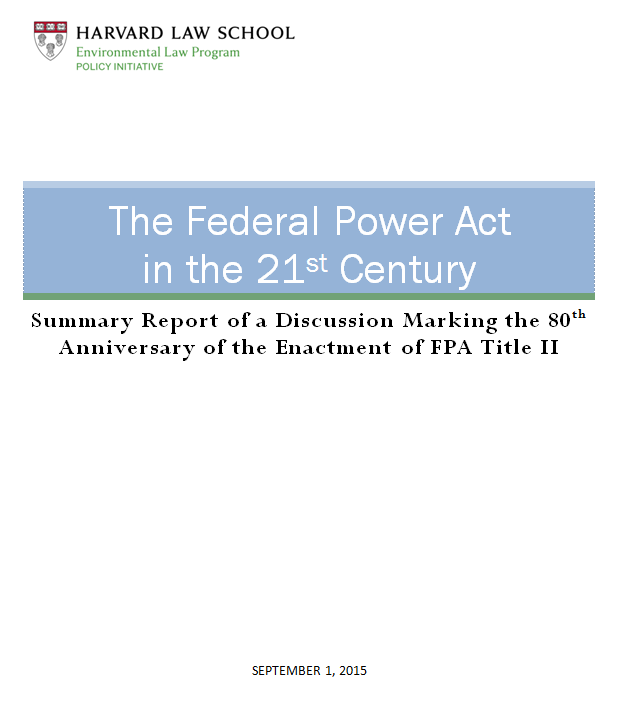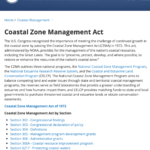The Federal Power Act, enacted by Congress in 1935, was the result of a long debate over whether the Federal Government should permit private interests to develop the hydroelectric potential of the waters of the United States, or whether it should reserve such development for itself for the public benefit. The Federal Power Act resolved this question by creating an independent commission (The Federal Power Commission, now known as the Federal Energy Regulatory Commission or FERC) with the exclusive authority to grant licenses permitting private and municipal developers to construct and operate hydropower projects. FERC’s decision to license a hydroelectric project must be in the public interest and must be “best adapted to a comprehensive plan for improving or developing a waterway” that considers multiple uses of that waterway, an evaluation that FERC describes as “balancing.” These licenses are granted for terms of up to 50 years, after which the licensee is presumed to have recouped its initial investment and must apply for a new license, subject to competing applications.
The Federal Power Act has been amended several times throughout its history. Two sets of amendments are particularly relevant today:
The 1986 Electric Consumers Protection Act (ECPA) amended the FPA in three key ways. First, it revisited the old public-private power debate, removing a provision that gave preference to municipal utilities when evaluating competing relicensing applications in order to address private utilities’ fears that they would lose their projects to municipalities. Second, it required that FERC issue new licenses for existing projects with terms of at least 30 years. Third, and most important from a river protection perspective, it addressed concerns that FERC was not adequately addressing environmental issues. ECPA required FERC to give “equal consideration to the purposes of energy conservation, the protection, mitigation of damage to, and enhancement of, fish and wildlife (including related spawning grounds and habitat), the protection of recreational opportunities, and the preservation of other aspects of environmental quality.” It also required FERC to solicit and address recommendations to benefit fish and wildlife from Federal and State natural resource agencies.
The 2005 Energy Policy Act eroded key environmental protections in the FPA, addressing the hydropower industry’s concerns over the costs associated with mandatory conditions imposed by other Federal agencies. Agencies have the power to impose mandatory license conditions (which FERC may not modify or reject) in order to protect federal reservations (e.g. the Forest Service protecting a national forest) or to provide fish passage. The 2005 act amended the Federal Power Act, giving any party to a licensing the right to request a trial-type hearing to challenge the material facts on which those conditions are based. Stakeholders may also propose alternative conditions that either cost less or allow for more power generation.
Learn more about the Federal Power Act, FERC, and how they relate to hydropower by reading our Hydropower Licensing Guide.
THE FEDERAL POWER ACT
Hydropower Licensing and Consideration of Environmental Values
I. OVERVIEW
There are over 2,000 hydropower dams in the United States with licenses issued by the Federal Energy Regulatory Commission (FERC) under the authority of the Federal Power Act (hereinafter “Act’). Most of the licenses issued by FERC between 30 to 50 years ago were issued with little or no attention given to environmental protection. As a result, many of the dam rental agreements we are living with today were designed solely to benefit power generation, written decades ago when we did not understand the damage that poorly operated dams do to our rivers.
Beginning in the early 1990’s, many of the licenses for these dams began to expire. In the next 15 years, 593 licenses will expire, affecting thousands of miles of rivers nationwide.. In the licensing process, dam owners can improve the health and recreational use of our rivers by:
- Restoring more natural river flows below their dams,
- Minimizing the fluctuations of reservoir levels,
- Providing fish with safe passage around their dams,
- Restoring habitat for river wildlife,
- Maintaining appropriate water quality—such as temperature and oxygen levels—in the river,
- Protecting riverside lands from erosion, and
- Enhancing recreational opportunities.
The Federal Power Act, 16 U.S.C. § 791-828(c), passed in 1920 and amended in 1935 and 1986, created the Federal Energy Regulatory Commission (FERC), an independent regulatory agency that oversees the natural gas, oil, and electricity markets, regulates the transmission and sale of these energy resources (except for oil), provides licenses for non-federal hydroelectric plants, and addresses environmental matters arising in any of the areas above. The agency is governed by a five member commission appointed by the President with the advice and consent of the Senate, 16 U.S.C. § 792.
II. HYDROPOWER LICENSING
The Federal Power Act (FPA) authorizes the Federal Energy Regulatory Commission (FERC) to issue exemptions or licenses to construct, operate and maintain dams, water conduits, reservoirs, and transmission lines to improve navigation and to develop power from streams and other bodies of water over which it has jurisdiction. 16 U.S.C. § 797(e). FERC’s jurisdiction extends to all hydropower dams not owned by the federal government that either:
- occupy federal public lands or federal reservations;
- are located on navigable streams;
- use surplus water or water power from a federal government dam; or
- were constructed after August 26, 1935 and are located on a non-navigable stream that affects the interests of interstate or foreign commerce (including providing power to an interstate power grid).
Navigable waters include parts of stream or other bodies over which Congress has jurisdiction to regulate commerce which, either in their natural or improved condition, are suitable for use to transport persons or property in interstate or foreign commerce. According to the Act, hydropower licenses are not to exceed 50 years in length. 16 U.S.C. §§ 797, 798-802.
III. CONSIDERATIONS OF THE PUBLIC INTEREST AND ENVIRONMENTAL ISSUES IN LICENSING
Before 1986, dam licenses issued by FERC primarily considered a river’s power generation potential in issuing licenses, often without regard for the project’s environmental impacts. The 1986 amendments to the Federal Power Act required FERC, when deciding whether to issue a license, to consider not only the power generation potential of a river, but also to give equal consideration to other values such as energy conservation, protection of fish and wildlife, recreational opportunities, and preservation of general environmental quality. In addition, more attention has been paid the 1920 Act’s requirements that FERC consult with other agencies and that licenses contain conditions discussed in more detail below.
[Note: Licensing private hydroelectric power projects regulated by FERC must also comply with laws other than the Federal Power Act such as the Endangered Species Act, Clean Water Act, and National Environmental Policy Act. This outline does not contain a discussion of these laws that can have significant impacts on the licensing process.]
A. Section 4(e)- Conditions Applying to Projects Located within a Federal Reservation
Under Section 4(e) of the Act, 16 U.S.C § 797(e), FERC must consider environmental requirements for licensing a project within a federal reservation. A federal reservation under the Act is a technical term, defined generally as a national forest, tribal land, military reservations, and other lands and interests in lands reserved for other public purposes. They include any lands and interests in lands acquired and held for any public purposes by the federal government (they do not include national monuments or national parks, where hydropower licensing is prohibited).
There are two substantive requirements for licensing a project within a federal reservation:
- FERC must find that the license will not interfere with or be inconsistent with the purposes for which the reservation was created or acquired.
- A license must be issued on terms that the federal agency responsible for the reservation finds are necessary for the adequate protection and utilization of that reservation. This is not a veto power, and the land managing agency may not prevent FERC from issuing the license. However, the land managing agency’s conditions must be included within the FERC license or it cannot be issued.
B. Section 18- Conditions Applying to Projects That May Affect Fish Passage
Section 18 of the Federal Power Act states that FERC “shall require the construction, maintenance, and operation by a licensee at its own expenses of such…fishways as may be prescribed by the Secretary of the Interior or the Secretary of Commerce, as appropriate.” 16 U.S.C. § 811. The federal fish agency may prescribe a fishway that, in its judgment, is necessary to maintain all life stages of the fish impacted by the project.
The prescription is limited to
- Physical structures, facilities, or devices necessary for such protection; and
- Project operations and measures related to structures, facilities, or devices necessary to ensure effectiveness.
These conditions may be applied in the FERC license or FERC may reserve its authority to include a fishway prescription in the future.
C. Section 10(j)- Requirement to Solicit Recommendations from Other Agencies
Amendments to the Act in 1986 added an additional requirement that FERC consider both power and non-power resources, and to solicit recommendations on license conditions from the U.S. Department of Commerce’s National Marine Fisheries Service, the U.S. Department of Interior’s U.S. Fish and Wildlife Service, and state fish and wildlife agencies. 16 U.S.C. § 803(j) (known as 10(j) recommendations).
FERC must give deference to these recommended conditions but can still alter or reject them by following prescribed procedures. A section 10(j) recommendation need not be included in a FERC license as opposed to a Section 4(d) or Section 18 requirement outlined above.
D. Section 10(a)- Giving Equal Consideration to Non-Power Values
In the 1986 amendments to the Act, Congress also broadened the scope of FERC’s duties, requiring the Commission to “give equal consideration to the purposes of energy conservation, the protection, mitigation of damage to, and enhancement of, fish and wildlife (including related spawning grounds and habitat), the protection of recreational opportunities, and the preservation of other aspects of environmental quality.” 16 U.S.C. § 801(a)(1) (Section 10(a)(1)). Thus, the Act obligates FERC to give equal consideration to non-power values.
Because FERC licenses are issued for terms between 30-50 years, relicensing is characterized as a “once in a lifetime” opportunity to restore many of the environmental and social values that characterized a river prior to existence of a dam. The Federal Power Act’s requirements to including consideration of public and environmental values in licensing proceedings has provided river advocates with a major tool for conservation and restoration. Since 1993, more than 400 projects have been relicensed.
Learn more about FERC licensing processes.


